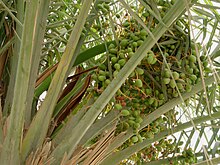Scientific classification
| Kingdom: | Plantae |
| Clade: | Tracheophytes |
| Clade: | Angiosperms |
| Clade: | Monocots |
| Clade: | Commelinids |
| Order: | Arecales |
| Family: | Arecaceae |
| Genus: | Phoenix |
| Species: | P. dactylifera |
Characteristics
The date palm tree or common date (Phoenix dactylifera L.) It is a plant from the palm family (Arecaceae). The tree is erect, robust, unbranched, growing up to 30 m high, leafy canopy up to 10 m wide. The diameter of the trunk is up to 2 m, densely covered with scars of dead leaves.
A number ofadventitious roots are created at the base of the trunk, and the right roots are up to 6 m high and up to about 18 m wide. The leaves are assembled in a rosette at the top; they are of smaller linearly pointed leaves about 30 cm long, about 2 cm wide. It is a bicameral plant, male and female flowers are created on separate plants and are clustered in dense clusters. It blooms in February, the pollination is done by the wind.
The fruit is oval cylindrical, a smooth ossicle 3-7 cm long, 2-3 cm wide, ripens in November and December when it turns dark brown. It contains one large seed about 2 cm long, 6-8 mm wide. It contains one large seed about 2 cm long, 6-8 mm wide.
Habitat – Range
It began to be cultivated from about 3000-6000 BC. It is believed to have originated in the Arabian Peninsula. It is grown for edible fruits, grows in dry and warm habitats. Propagation is by seed or more often by cuttings because the seeds are often given by male trees that do not bear fruit.
The seeds require high humidity and heat of about 15-20 ° C, germinating after about a month. On average, half of them yield male and female plants, but they do not give birth until after 8-20 years, so vegetative propagation is preferred in cultivation, because except that the new plant takes on the same characteristics, the tree gives birth after 3-4 years.

Use
They are edible fruits, rich in sugar, eaten fresh or dried and used to make other foods and sweets. They get fiber from the foliage used to make baskets or cover roofs.
